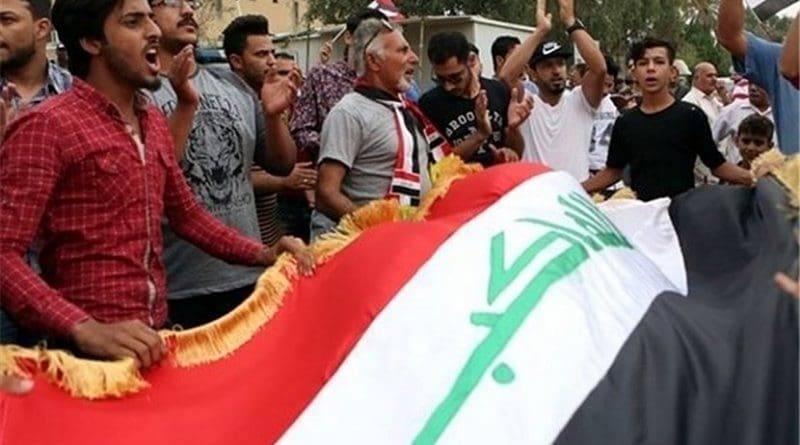Protests In Southern Iraq: Lessons For Iran’s Post-Conflict Strategy In Syria – Analysis
By IPCS
By Pieter-jan Dockx*
In July 2018, mass protests swept provincial capitals in Shia-majority southern Iraq, demanding improvements in the provision of public services like potable water and electricity. While protests for better services are common in southern Iraq, the palpable anti-Iran sentiment witnessed during the recent demonstrations marked a noticeable shift from previous protests in the region. This antagonism towards Tehran is largely the result of the perceived association between the Iraqi political class that is held responsible for the said grievances, and Iran. Lessons can be drawn regarding vis-à-vis Iran’s consolidation strategy in Syria by comparing the growing anti-Iran sentiment in Iraq to Lebanon, where support for Iran’s ally, Hezbollah, seems to be increasing. Although both Iraq and Lebanon have inadequate governance systems, Hezbollah does provide its constituency with sufficient services, which leads to greater popular support. This analysis looks at the situation from Iran’s vantage point, and argues that Tehran would not want to omit this socioeconomic aspect in its strategy to entrench itself in post-conflict Syria.
The hostility towards Iran in southern Iraq is primarily caused by Tehran’s perceived relationship with the political parties that have governed Iraq for the last 15 years and have failed to provide sufficient and good quality public services. After the US invasion of Iraq, Iran was able to expand its influence in Baghdad to the extent that it now faces shared responsibility for the country’s ills. Iran has mainly focused on increasing its influence over ’Iraq’s security apparatus while largely neglecting socioeconomic policymaking, conveniently making Baghdad more dependent on Tehran. Recently, for various reasons, Iran cut electricity supplies to Iraq, further exacerbating the existing crisis in the country’s south. In the supposed absence of a unifying threat like the so-called Islamic State, all these grievances associated with Iran have now come to the fore.
This popular discontent threatens Tehran’s interests in the country. Southern Iraq is predominantly Shia and has long been Iran’s closest ally in the country. With Iraq’s Sunni population traditionally suspicious of Iranian influence, Tehran would want to avoid further alienating the country’s Shia majority as well. The protests also open the doors to actors that aim to reduce Iran’s influence in Iraq. Shia cleric Moqtada al-Sadr—who contested the general election with a nationalist and partly anti-Iran discourse—has made various attempts to capture the movement. The Iraqi government has also turned to Iran’s regional adversary, Saudi Arabia, to bridge the electricity supply gap created by Tehran.
The Iraqi case stands in sharp contrast to the popularity of Iran’s local Shia ally in Lebanon, Hezbollah, which safeguards Tehran’s interest in the country. In Lebanon’s May 2018 general election, Hezbollah and its (Shia and Sunni) allies won a majority of seats in the parliament. This was a notable improvement compared to their performance in the previous elections, and arguably, an indication of increased support for the group. While Lebanon and Iraq have equally ineffective state apparatuses, Hezbollah operates as a state within a state, providing its own public services to its constituents in sectors such as education and healthcare, more effectively than the state’s public service delivery systems. With the electoral campaigns in both Iraq and Lebanon primarily focused on these socioeconomic factors, Iran’s ally in Lebanon was able to demonstrate tangible results whereas its allies in Iraq rehashed the same old empty promises. Furthermore, while Hezbollah only had a minority stake in the previous failing Lebanese governments, Iran’s allies in Baghdad have been in power throughout the post-Saddam Hussein period of failed governance. Thus, unlike politicians in Iraq, Hezbollah has a credible narrative when it dodges the blame for central government failure in Lebanon.
These two examples demonstrate how Iran would not want to neglect this socioeconomic aspect in its efforts to consolidate its presence Syria. While Iran’s current activity in Syria is being legitimised by an existential ‘terrorist’ threat to the state, the current crisis in Iraq demonstrates that this situation will not last indefinitely. However, the nature of Syrian state and conflict means that Iran cannot emulate the Hezbollah social model to a tee. While Tehran’s allies in Baghdad have more or less captured the state and Hezbollah operates in Lebanon as a proto-state, Iran-linked groups in Syria have been integrating in the existing Assad regime. Thus, unlike in Lebanon and Iraq, Iran’s allies in Syria will be unable to act with the same degree of autonomy. Although this could potentially hamper Iran’s attempts to implement the strategy of providing public services, it also provides Tehran the ability to pass the buck if need arises.
The targeting of Iran during recent protests in Iraq’s Shia heartland has exposed the flaws in Tehran’s strategy towards its neighbour. Given the imminence of Syria’s post-conflict phase, Iran would want to avoid repeating the mistakes it made in Iraq. Although Tehran will have to take into account local power dynamics, Tehran’s consolidation policy in Syria will succeed only if guided by the socioeconomic aspect of the Hezbollah model.
*Pieter-jan Dockx
Researcher, Centre for Internal and Regional Security (IReS)

